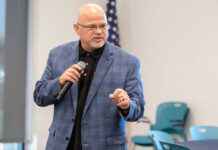
While the holidays bring a lot of joy, they also bring pressure to get more done in a shorter period of time. Additional errands, shopping and appointments challenge us all to become masters of time management.
After battling traffic and repeatedly circling the parking lot, moving farther and farther from your destination, it may be tempting to take that spot, you know the one, right in front marked “accessible.” “I’ll just be a minute, so it won’t matter much. It’s only for a minute, after all.”
Has this ever crossed your mind? Have you ever chanced it? Just for a minute?
Consider this: aside from the risk of getting a hefty ticket for illegal use of these parking spaces, there’s an even more compelling reason to preserve these spots. Knowing the hassles holiday shopping brings for the average American, think about the millions of Americans with disabilities who shop along side them. Arizona has the largest population in the nation for adults with disabilities – 20 percent. And, the Americans with Disabilities Act (ADA) – which celebrated its 20th anniversary this year – has a set of guidelines for retailers to abide by; as a consumer it’s important to know and respect these guidelines, too.
Accessibility
The ADA requires that stores owning and operating parking lots must provide accessible parking – spaces reserved for people with disabilities who display the appropriate license plate or mirror tag. Stores controlling the sidewalk outside their stores must also provide curb ramps if easily achievable.
Once parked, mobility in the store is essential. Many barriers to accessibility are often overlooked and could be as simple as merchandise displays that block an aisle or doorway. Barriers have the potential to trip a customer who is visually impaired or prevent a person using a wheelchair from maneuvering around objects and should be removed.
Elevators
Elevator etiquette is simple: escalators and stairs are for individuals without disabilities; elevators should be reserved for those requiring their use. According to “Elevators and the ADA,” a report prepared by John F. Mundt, Jr. of Sterling Elevator Consultants, LLC, if easily achievable, stores should install raised letters and Braille on the control panels and outside the doors for customers who are visually impaired. Additionally, placing a large, high-contrast sign indicating the floor number outside the elevator and opposite the elevator door helps orient people with limited vision. Lastly, the ADA also requires retailers to adjust door timers to allow adequate time to enter and exit the elevator. When elevators are not necessary, but stairs are present, ramps should be made available.
Amenities
While, according to the ADA, stores are to have accessible facilities such as drinking fountains, dressing rooms and restrooms when easily achievable, this does not ensure they will always be available to persons with disabilities. It’s important, for example, to forgo using the accessible dressing room simply because it allows a person without a disability more room to dress. Please show appropriate consideration and reserve these facilities for the people who need them.
Communication
Often communication needs to be considered when effectively communicating with a person with a disability. For instance, writing on a notepad in order to converse with a person who is hearing impaired or reading signage to a person who is visually impaired are both simple accommodations.
Other simple solutions to make shopping accessible for all consumers, according to The Americans with Disabilities Fact Sheet Series, produced by the Adaptive Environments Center, include:
• Placing lightweight items on higher shelves and heavier items on lower shelves; aware and helpful sales clerks can also offer assistance in reaching items.
• Providing temporary storage area for items selected by people who cannot use shopping carts, as it may be necessary for many of these individuals to make several trips to the check-out counter to complete their purchases.
• Using color-coded pictorial maps showing what and where products are sold in the store and hanging a sign with a large question mark over customer service areas can be a benefit to people with cognitive disabilities.
The more accessible a store is, the easier shopping is for both individuals with disabilities and for their fellow shoppers. Awareness is key to accessible holiday shopping. For more information on accessibility issues, please visit www.abil.org.
Phil Pangrazio is the executive director of Arizona Bridge to Independent Living.
InMaricopa.com encourages readers to submit their thoughts and opinions on issues and events affecting Maricopa, Pinal County and Arizona. Please send 400 words or less to [email protected]. Include your full name, phone number and e-mail address along with any attribution you want included. If you have a good headshot of yourself, please send that too, attached as a JPG file. Letters and opinion pieces may be edited for length.









![City gave new manager big low-interest home loan City Manager Ben Bitter speaks during a Chamber of Commerce event at Global Water Resources on April 11, 2024. Bitter discussed the current state of economic development in Maricopa, as well as hinting at lowering property tax rates again. [Monica D. Spencer]](https://www.inmaricopa.com/wp-content/uploads/2024/04/spencer-041124-ben-bitter-chamber-property-taxes-web-218x150.jpg)


![In mayoral race, it’s the Nancy Smith show Maricopa Chamber of Commerce Executive Director Kelly Anderson grills incumbent Mayor Nancy Smith in election's first campaign event April 30, 2024, at Southern Dunes Golf Club. [Elias Weiss]](https://www.inmaricopa.com/wp-content/uploads/2024/04/CRM_1009-100x70.jpg)
![Merging lanes incite more 347 anger A merging lane sign sits on the side of State Route 347 northbound lanes during evening traffic on April 30, 2024. [Monica D. Spencer]](https://www.inmaricopa.com/wp-content/uploads/2024/04/spencer-043024-adot-merging-lanes-347-web-100x70.jpg)

